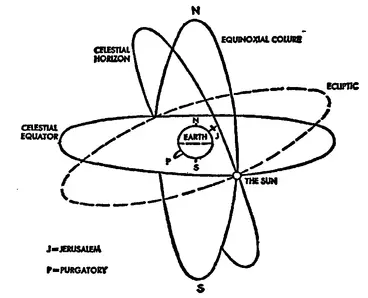The celestial equator is the infinite extension of the plane of the earth’s equator into the celestial sphere.
When the sun is in the position shown in the diagram the time is sunrise of the vernal equinox and all four circles meet, each of the other three forming a cross with the celestial horizon. Astrologers took this to be a particularly auspicious conjunction. Its happier course (line 40) brings the brighter and longer days of summer. Its happier conjunction (line 40) with the stars of Aries bring it back to the sign of the first creation (see Interno, I, 38-39, note). And certainly the fact that the diagram forms three crosses would weigh it with the good omens of both the cross and trinity. All would once more be in God’s shaping hand. So the wax of the world (line 41) is warmed and sealed, in a first sense by the warmth of approaching summer, and in a clearly implicit spiritual sense by the favor of God’s will upon His creation.
This complicated figure could hardly have failed to suggest, further, some reference to the Four Cardinal Virtues, the Three Theological Virtues, and to the approaching Sun as Divine Illumination, now drawing to the full summer of mankind—for bear in mind that the southern hemisphere, in Dante’s geography, was all water: there would be no mankind for the Sun to shine upon in its southern summer.

43-44. evening here and morning there: At the time Dante returned from drinking the waters of Eunöe. It is now noon, for only at noon could the entire southern hemisphere be alight and the north dark—or so Dante must clearly intend, though I do not understand how that could be.
46. had turned left: Beatrice had been facing east with Eunöe before her. She now turns her eyes north to the sun.
47. no eagle ever: In the Middle Ages men believed that the eagle was able to stare directly into the sun.
49-54. and as a ray: Just as a descending ray of light strikes a reflecting surface and sends a reflected ray back upward, and at the same angle at which it struck the surface, so Beatrice’s action in looking at the sun descends upon Dante like a ray from on high that enters through his eyes and strikes upward to his mind giving rise to a “reflected” action.
62. day was added to day: Dante perceives the increased brilliance of the light as if God had added a second sun to the sky, and he wonders at it. He does not yet know that the light has grown so much more brilliant because he is soaring through space toward the sun. He believes himself to be still in the Terrestrial Paradise.
Dante’s device here, in showing himself as soaring toward God at enormous speed without, at first, realizing that he is soaring, is a superbly conceived climax to the whole theme of Purification as Gradual Weightlessness. In Hell all is gross and heavy. At the start of the Ascent of Purgatory, Dante almost drops from exhaustion. As he mounts and sin is stricken from him, he climbs ever more lightly. Now purified and perfected, he need not even think about mounting on high. His new nature draws effortlessly to God.
68. Glaucus: The fisherman Glaucus, noting how his catch revived and leaped into the sea after being laid upon a certain herb, ate some of it and was transformed into a god (Ovid, Metamorphoses, XIII, 898-968). Staring at Beatrice, Dante feels the beginning inside himself of that change that will make him, too, immortal.
73-75. the last created part of my being: The soul, which is created after the body. (See Purgatorio, XXV, 37-75.) O Love that rulest Heaven: God. whose lamp: Beatrice as the reflector of God’s love.
76-78. The Great Wheel etc.: Dante says, literally: “The wheel that Thou, in being desired [i.e., loved] by it, makest eternal.” The Great Wheel is the Primum Mobile, its motion deriving from the love of God. captured my attention: Indicates that Dante turned his eyes from Beatrice to look up again. that harmony: The Music of the Spheres.
80. ablaze with sun: Dante believed that the earth’s atmosphere extended as high as the Sphere of the Moon.
1 comment